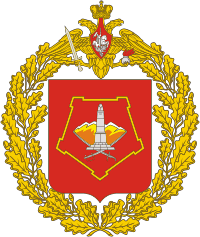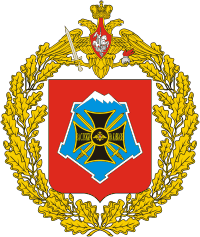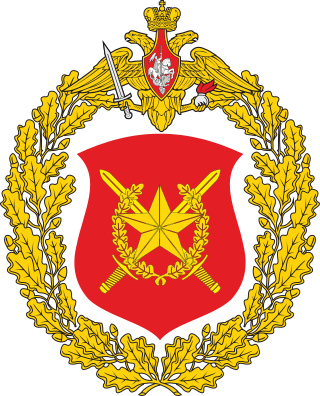
The Russian Naval Infantry, often referred to as Russian Marines in the West, operate as the naval infantry of the Russian Navy. Established in 1705, they are capable of conducting amphibious operations as well as operating as more traditional light infantry.
A mechanised corps was a Soviet armoured formation used prior to the beginning of World War II and reintroduced during the war, in 1942.

The Russian 201st Military Base is a Russian military base based in Dushanbe, Tajikistan, part of the Central Military District. It was originally raised twice in World War II as part of the Soviet Union's Red Army and is now part of the Russian Ground Forces.

The Leningrad Military District was a military district of the Armed Forces of the Russian Federation. In 2010 it was merged with the Moscow Military District, the Northern Fleet and the Baltic Fleet to form the new Western Military District.

The Volga–Ural Military District was a military district of the Russian Ground Forces, formed on 1 September 2001 by the amalgamation of the Volga Military District and the Ural Military District. The headquarters of the Ural Military District, located at Yekaterinburg became the new headquarters of the merged district. In 2010 the District was merged with part of the Siberian Military District to form the new Central Military District.

The North Caucasus Military District was a military district of the Russian Armed Forces, which became in 2010 the Southern Military District and lately also included the Black Sea Fleet and Caspian Flotilla.

The 2nd Guards M. I. Kalinin Taman Motor Rifle Division, commonly known as the Tamanians or Taman Division, is a Guards mechanised infantry division of the Russian Ground Forces. Its Military Unit Number (V/Ch) is 23626.

The 19th Voronezh-Shumlinskaya Red Banner Order of Suvorov and Red Banner of Labor Motor Rifle Division, is a division of the Russian Ground Forces. It appears to have been formed originally in July 1922 at Tambov in the Moscow Military District as a territorial formation. In 1923 it was awarded the 'Tambov' placename and renamed the 19th Voronezh Rifle Division. The division was downsized to a brigade in 2009 and reestablished as a division in 2020.

The 35th Combined Arms Red Banner Army is a field army of the Russian Ground Forces. The army was first formed in July 1941 with the Far Eastern Front. After spending most of World War II guarding the border in Primorsky Krai, the army fought in the Soviet invasion of Manchuria in August 1945, and was disbanded shortly after the end of the war. Reformed at Belogorsk when Sino-Soviet tensions rose in the late 1960s in the Far East, the army became part of the Eastern Military District in 2010.
The 85th Leningrad-Pavlovsk Red Banner Motor Rifle Division was an infantry division of the Soviet Red Army converted to a motorised formation in 1957. It was part of the Russian Ground Forces until it was reorganised as the 32nd Separate Motor Rifle Brigade in 2009. In 2016, the 32nd Separate Motor Rifle Brigade was reorganised as the 228th Motor Rifle Regiment of the 90th Guards Tank Division.
The 3rd Shock Army was a field army of the Red Army formed during the Second World War. The "Shock" armies were created with the specific structure to engage and destroy significant enemy forces, and were reinforced with more armoured and artillery assets than other combined arms armies. Where necessary the Shock armies were reinforced with mechanised, tank, and cavalry units. During the Second World War, some Shock armies included armoured trains and air–sled equipped units.
The 9th Bobruisk-Berlin Red Banner Order of Suvorov Tank Division was the designation of two separate formations of the Soviet Army. The original 9th Tank Division was formed in 1940 and later reorganized into a different division. During World War II, the Soviet Army formed the 9th Tank Corps, which was renamed the 9th Tank Division after the defeat of Germany in 1945. This second instance of the 9th Tank Division served with the Group of Soviet Forces in Germany from 1945 until about 1991, when it was disbanded.
The 11th Tank Division was a Soviet tank division initially formed in 1940 at Tiraspol and destroyed in 1941; it was then formed as a tank corps in May 1942. This unit was subsequently reorganized as the second formation of the 11th Tank Division in 1945.

The 19th Guards Mechanized Brigade is a formation of the Armed Forces of Belarus based in Zaslonovo, a few kilometers east of Lepiel. The brigade traces its history back to the 1942 formation of the 2nd Guards Mechanized Corps of the Soviet Army during World War II. Subsequent designations during the Cold War included 2nd Guards Mechanized Division and 19th Guards Tank Division. Following the Cold War, the 19th Guards Tank Division was relocated to Belarus and became part of their armed forces in 1992. Thereafter, the unit was reduced to a personnel and equipment cadre unit and titled the 19th Guards Base for Storage of Weapons and Equipment before being upgraded to a mechanized brigade in 2008.
The 69th Rifle Division was an infantry division of the Red Army and later the Soviet Army, formed twice.
The 213th Motor Rifle Division was a motorized infantry division of the Soviet Army. The division was based in Totskoye and existed from 1968 to 1991. In 1991, the division merged with the 27th Guards Motor Rifle Division.
The 12th Motor Rifle Division was a motorized infantry division of the Soviet Army, formed twice. It was formed in 1957 from the 12th Rifle Division and disbanded in 1958. The division was reformed in 1960 and moved to Baganuur in Mongolia in 1979. It pulled out of Mongolia in 1990 and became a storage base in 1992. The storage base was disbanded in 1993.
The 341st Rifle Division was first formed in September 1941, as a standard Red Army rifle division, at Stalingrad. It was a "sister" unit to the 335th Rifle Division, which was formed at about the same time and place and shared a very similar combat path in its first formation. It was assigned to the southern sector of the Soviet-German front during the winter counteroffensive, but was effectively destroyed during the German spring offensive that formed the Izium Pocket, and was soon disbanded. The division was formed again almost exactly two years later, this time in the Karelian Front, facing Finland, and saw only limited action in the Continuation War before being assigned to coastal defense duties during 1945. While the 341st had one of the shortest and least distinguished careers of any Soviet division in the Soviet-German War, it continued to serve well into the Cold War, eventually being re-designated and becoming a motorized rifle division.

The 336th Independent Guards Bialystok Orders of Suvorov and Alexander Nevsky Naval Infantry Brigade is a brigade of the Russian Naval Infantry, formerly part of the Soviet Naval Infantry.
The 15th Guards Mozyr Red Banner Order of Suvorov Tank Division was a tank division of the Soviet Army during the Cold War that became part of the Russian Ground Forces after the dissolution of the Soviet Union.









